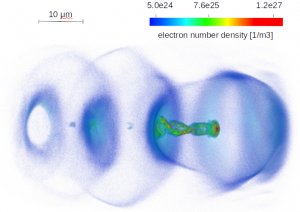For many applications in bio-, molecular, nano-, and materials science, bright light sources in the soft X-ray region (50 – 1500 eV) are needed in order to access C, N, and O absorption edges, enabling high contrast, element-specific spectroscopy and microscopy. In order to investigate structural phenomena on the level of a crystalline unit cell, even hard X-rays (1.5 – 15 keV) are to be used. Femtosecond hard X-ray pulses provide a convenient way to map the dynamics of fast structural phase transitions or lattice excitations, for example, initiated by a strong laser pulse.
The well-known process of high-harmonic generation (HHG) is currently our method of choice to produce femtosecond X-ray bunches with photon energies up to roughly 200 eV with our Thales laser system. However, increasing the intensity of the driving laser leads to ionization depletion of the target atoms. This effectively sets a maximum limit on the applicable fundamental laser intensity to I0 ![]() W/cm
W/cm![]() . Beyond this, the photon energy can only be increased by operating at longer wavelengths. Hence, over the past years the development of mid-infrared lasers using optical parametric chirped-pulse amplification (OPCPA) has been a major line of investigation. However, such sources are still in an experimental stage, in particular due to the complexity of OPCPA lasers. Furthermore, it is challenging for HHG source to produce circularly polarized radiation.
. Beyond this, the photon energy can only be increased by operating at longer wavelengths. Hence, over the past years the development of mid-infrared lasers using optical parametric chirped-pulse amplification (OPCPA) has been a major line of investigation. However, such sources are still in an experimental stage, in particular due to the complexity of OPCPA lasers. Furthermore, it is challenging for HHG source to produce circularly polarized radiation.
A promising alternative to HHG are plasma light sources based on laser-driven electron acceleration. Here, an intense laser pulse excites a plasma wakefield with strong longitudinal fields (GV/m to TV/m) and electrons that are properly coupled to these fields can be efficiently accelerated. The actual energy yield depends on the laser and plasma parameters: Terawatt lasers reach MeV energies, while experiments at petawatt-scale lasers have reported energies of several GeV. Laser-plasma accelerators can thus provide highly relativistic electron beams and the relativistic doppler effect allows to convert their energy to high energies photons.

The Jülich contribution to the ATHENA project is to develop a develop high-repetition rate Betatron radiation source in the keV energy range and use new schemes to control the X-ray polarization state. At the given laser intensity of our laser systems with pulse energies not higher than 40 mJ, this requires, as a first step, a careful optimization of the electron acceleration process with the help of Particle-In-Cell (PIC) simulations as well as novel target technologies.

PIC simulations

The figure shows the cavity regime of electron acceleration using a 20 fs laser pulse with intensity of ![]()
![]() sent through a helium gas target. 3D Particle-in-Cell simulations show that electrons can be accelerated to 80 MeV over 260
sent through a helium gas target. 3D Particle-in-Cell simulations show that electrons can be accelerated to 80 MeV over 260 ![]() propagation length, giving an average electric field gradient of 300 GV/m.
propagation length, giving an average electric field gradient of 300 GV/m.
